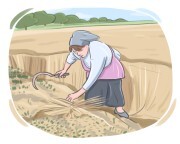자연 과학 SAT - 농업과 임업
여기에서는 SAT를 잘 보기 위해 필요한 "반건조", "관개", "멀칭" 등과 같은 농업 및 임업과 관련된 몇 가지 영어 단어를 배우게 됩니다.
리뷰
플래시카드
철자법
퀴즈

to cut and collect a crop

수확하다, 거두다
to grow plants or crops, especially for farming or commercial purposes

재배하다, 기르다
(of a farm or an industry) to grow or produce a crop or product

생산하다, 주다
to use a large farming equipment to dig the ground and make it ready for farming

밭을 갈다, 땅을 일구다
to break up the surface of the ground, remove weeds, etc. using a gardening tool with a thin metal blade attached to a long handle

괭이질하다, 잡초를 제거하다
to prepare the soil for planting by digging, stirring, or turning it over using a tool such as a plow or a tiller

경작하다, 밭을 갈다
a chemical or natural material that is added to the soil to improve its productivity and help plants grow

비료, 영양제
the artificial application of water to land or soil to assist in the growing of crops and the maintenance of landscapes

관개, 물공급
the process by which water on the ground surface enters the soil, replenishing soil moisture and reducing runoff

침투, 물이 토양으로 스며드는 과정
the amount of water falling to a particular location over a specified period
characterized by receiving very little rainfall, often with erratic precipitation patterns and a tendency towards drought conditions, but not as extreme as arid climates

반건조, 반건조의
relating to trees with hard and dry fruits called cones and needle-shaped leaves

구과 식물의, 바늘잎의
the practice of cultivating and managing forests, including the planting, growth, and harvesting of trees for timber production and ecosystem maintenance

조림, 산림 관리
an agricultural system where landowners allow tenants to use the land in exchange for a share of the crops produced

소작제, 분익소작
a farming approach that uses technology to optimize crop production by precisely managing resources like water, fertilizer, and pesticides

정밀 농업, 정확한 농업
a farming system that combines agriculture with livestock grazing, where both activities are practiced on the same land

농목업, 농목 시스템
a young plant that develops from a seed, typically in the early stages of growth after germination

묘목, 어린 식물
(of food or farming techniques) produced or done without any artificial or chemical substances

유기농의, 자연적인
a chemical substance or agent that is used to kill or control insects that can cause harm to humans, crops, animals, and structures

살충제, 해충 방제제
a type of chemical substance that is used for killing insects or small animals that damage food or crops

농약, 살충제
a chemical substance that kills plants, used for destroying plants that are not wanted

제초제
to create stepped levels or flat areas on sloped land to prevent erosion and make the land suitable for farming or forestry

계단식으로 만들다, 테라스를 만들다
solid waste from animals spread on a piece of land to help plants and crops grow healthier and stronger

거름, 퇴비
decayed leaves, plants, or other organic waste turned into a mixture that can improve the soil's quality and productivity once added to it

퇴비, 유기 비료
a protective layer of decaying leaves or compost that is spread over or around a plant to improve the quality of the soil, stop weeds from growing, or to provide protection for the plant's base and its roots

멀칭, 뿌리 덮개
the layer of decomposing organic matter, such as leaves, twigs, and other plant material, that accumulates on the soil surface

낙엽층, 부식질 층
to rid a garden or other area of land of unwanted plants

잡초를 제거하다, 제초하다
to deliberately mate individuals of different breeds or varieties to produce offspring with desirable characteristics or traits

교배시키다, 잡종화하다
a plant disease that causes withering, discoloration, or death without immediate rotting

시들음병, 그을음병
small animals or insects that are believed to be destructive and are difficult to handle when they appear in a considerable number

해충, 유해 동물
the act of cutting down trees to use their wood

벌목, 목재 채취
the presence of large numbers of harmful insects, pests, or other organisms in an area, often causing damage to crops, trees, or natural environments

감염, 침입
related to agriculture, farmers, or rural life

농업의, 농�의
a barren area of land that is unsuitable for agriculture or habitation

황무지, 불모지
a method of growing plants without soil, using nutrient-rich water solutions

수경 재배, 영양분이 풍부한 수용액을 사용하여 흙 없이 식물을 재배하는 방법
the excessive nutrients in water causing algae blooms, oxygen depletion, and ecological problems

부영양화, 과도한 영양염류 풍부화
small seeds of a large crop that grows in warm regions, used to feed birds or make flour

기장, 기장
a tall plant growing in Central America that produces yellow seeds, which are used in cooking

옥수수, 강냉이
a group of edible plants that are typically harvested and cooked while still immature

호박, 애호박
a plant with bright orange or yellow flowers that produces seeds rich in oil

홍화, 사플라워
the flower head of a plant from the cabbage family that is white in color and is eaten as a vegetable

콜리플라워, 양배추 꽃
aquatic plants with finely divided underwater leaves, found in freshwater habitats like lakes and ponds

밀포일, 물 아래에서 잘게 갈라진 잎을 가진 수생 식물
a deciduous tree known for its smooth bark, typically found in temperate and boreal forests

자작나무, 흰자작나무
a thread-like structure found in fungi, consisting of a chain of cells that collectively form the fungal mycelium, essential for nutrient absorption and growth

균사, 곰팡이 실 구조
a long green vegetable with edible stems, used in cooking or eaten raw

아스파라거스
a type of fruit belonging to the Cucurbitaceae family, typically with a hard outer shell, often used for containers, utensils, or as ornamental decorations

호리병박, 호박
an edible root of red color with a pungent taste that is eaten raw in salads

무, 홍무
a tall evergreen tree with fine-grained wood, valued for construction and known for its dense foliage

솔송나무, 독미나리
any type of plant whose pods contain seeds, such as peas and beans

콩과 식물, 콩류



























